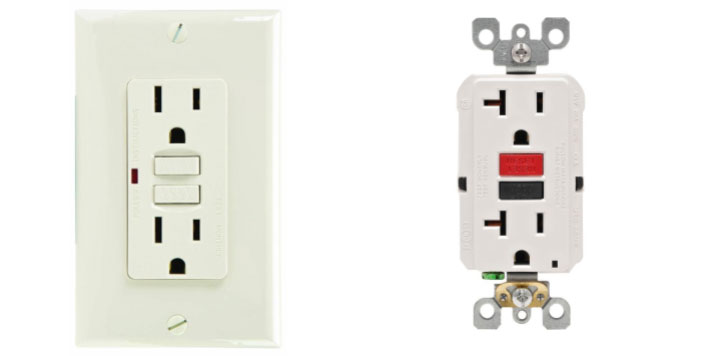Recently we had a customer whose brand-new dishwasher suddenly had no power to it. They thought the outlet was bad and had our technician come out to investigate. When the tech arrived on the scene, he quickly determined the lack of power was due to a tripped GFCI outlet, and by looking at the placement of the dishwasher outlet, was able to find the offender on the back porch. Not where one would typically think to look for a GFCI connected to the dishwasher. From here our tech simply pressed a button and viola power was restored! We love it when we can save the day so easily, but we wanted to also save customers time and money by teaching them about these trippy little plugs so they can be their own superhero at home.
Here is a quick reference step-by-step:
- Put on your explorer hat and go on the hunt for GFCI outlets and reset/test them to see if one of them has tripped. Be sure to do a thorough search inside and, as our customer learned, outside as well.
- If that does not restore power find your electrical box and be sure all the breakers are in the “ON” position. You may even need to cycle them by turning them off then back on. We talk about this here: {link to blog post article on checking breakers}
- If you still cannot restore power to the outlet give us a call at (480) 725-8099 or start a chat with us here on the site and we can schedule a diagnosis of the issue and replace outlets if needed.
- If we determine the issue to be within the wall or wiring, then we will connect you with one of our specialists – a trusted, licensed electrician to get the job done.
Read on for more details on these steps and this important device!
Here it is, the ground-fault circuit breaker (aka: the GFCI):

These little outlets can also be called residual-current device (RCD) or residual-current circuit breaker (RCCB). Most look like one of the above pictures but there are some other types in the market that look a little different. There is typically a “Test” button, a “Reset” button and it may also have an indicator light. Their purpose is to quickly “break” an electrical circuit to help prevent serious harm due to continuous electric shock. So, if the sensor inside reads an unusual influx or outflow of electricity it will open a switch within that “breaks” the flow of electricity through the circuit, cutting power to the outlets connected to that circuit.
As a kid I used to hear stories about people who were electrocuted by a faulty outlet and still remember the warnings to use a wooden broom handle or spoon to try and break them free from the outlet, to prevent adding myself to the circuit as well. I did not totally understand the why behind the warning until I was older. I was in a physics class in high school when we were learning about electricity and currents. The teacher called me up to participate in a demonstration where I held two metal rods connected to a light bulb, and on the other side a wheel that the teacher would turn to produce electricity. When the light bulb was screwed in it took much of the electricity to light it and a small amount continued to the metal rods and to my hands. It felt tingly and strange, and I even think my hair stood up a bit. I could still drop the rods if I wanted to and remove myself from the circuit. Then the teacher unscrewed the light bulb and began turning the wheel quickly, increasing the electric current. As the unhindered current hit me through the rods my muscles tensed and I could not open my hand to drop the metal rods, though I very much wanted to from the pain of electric shock! Let me tell you, it did not feel very good, and the sensation of not having control of your body was terrifying! After that experience I can appreciate the purpose and power of these little superhero outlets.
The importance of having GFCI outlets is obvious, but it does you no good if they are not functioning normally. Luckily, they have a built-in way to test them to make sure they are “on duty”. To test them you simply press the “Test” button, which is usually the bottom one, or the black button on the colored version. Most will be labeled as well so look closely.
When it trips (meaning the sensor opened the internal switch), the first thing you want to do is unplug anything that is directly in the outlet. Next you want to push the reset button, usually the top or red button (look for the label). This should close the switch and reestablish power to the outlet. You can then test if the outlet has power by plugging in an electronic device and turn it on. If it works then power has been restored, hooray! If it does not work, then you have a little more trouble shooting you can do before calling in the big guns.
If you cannot restore power using the reset button or if it continues to trip repeatedly (and you have checked the breakers on the electrical panel to be sure they are on-we talk about that here: {link to blog post on checking circuit breakers}) the outlet may need to be replaced. We can totally help with that so give us a call today at (480) 725-8099, or chat with us through our website.
In some cases, the problem goes a little deeper and it is important in these circumstances to get a licensed electrician out to check the wiring and make sure there is not a more serious concern. We work with trusted electricians that we use for our own needs and are happy to help connect you with our dependable, high quality professionals.
Hopefully, this post helps you understand these important devices a little better and gives you some troubleshooting help if you run into an outlet with no power. As always, give us a call or chat today if you feel you need the help of a pro! We are here to Save your Saturdays by giving you back time and energy through our efficient experts!





